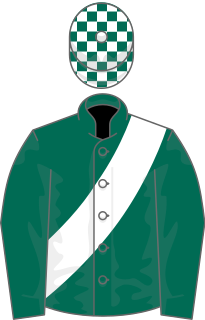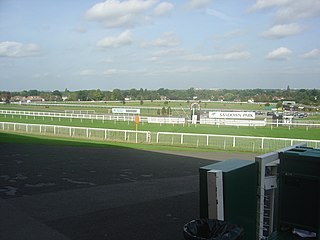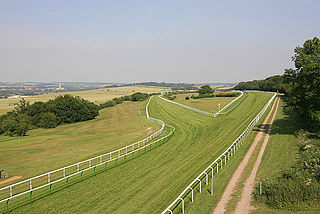
Bireme was a British Thoroughbred racehorse and broodmare best known for winning the classic Epsom Oaks in 1980. After winning one of her two starts in 1979, she won the Musidora Stakes on her three-year-old debut before winning the Oaks in record time. Later that summer she broke loose during a training session and sustained career-ending injuries. She was retired to stud with a record of three wins in four races and has had some influence as a broodmare.
Fairy Footsteps was a British Thoroughbred racehorse and broodmare best known for winning the classic 1000 Guineas in 1981. She showed promise in her first two races as a two-year-old before establishing herself as one of the best fillies of her generation with an emphatic win in the Waterford Candelabra Stakes. In the spring of 1981 she was heavily backed for the 1000 Guineas before and after a win in the Nell Gwyn Stakes. She won the 1000 Guineas by leading all the way and was considered highly likely to follow up with a win in the Epsom Oaks but was retired after a disappointing defeat in the Musidora Stakes. She had some success as a broodmare.
Detroit was a French Thoroughbred racehorse and broodmare who won the Prix de l'Arc de Triomphe in 1980. Unraced as a two-year-old, Detroit won her first four races in 1980 including the Prix Fille de l'Air, Prix Chloé and Prix de la Nonette. She was beaten when favourite for the Prix Vermeille before winning the Arc in record time. She remained in training as a four-year-old and won three more races including the Prix Foy. She was retired to stud where she produced the Arc de Triomphe winner Carnegie.

Scintillate was a British Thoroughbred racehorse and broodmare best known for winning the classic Oaks Stakes in 1979. She showed promising form as a two-year-old although she failed to win in three races. After recording her first win in the Sandleford Priory Stakes in the following spring she won the Oaks as a 20/1 outsider. She ran poorly in two subsequent races and was retired to brood where she had limited success as a broodmare.

Fair Salinia was a British Thoroughbred racehorse and broodmare best known for winning the classic Oaks Stakes in 1978. In a racing career which lasted from September 1977 until September 1978 she won four of her eight races. As a two-year-old in 1977 she won on her debut before finishing second in the Cheveley Park Stakes. As a three-year-old she finished second in the 1000 Guineas before being moved up in distance and winning the Oaks, Irish Oaks and Yorkshire Oaks. She was retired to stud at the end of the season and had some influence as a broodmare. She died in 2004 at the age of twenty-nine.
Sarah Siddons was a French-bred, Irish-trained Thoroughbred racehorse. She was a well-bred mare, being descended from a half-sister of the outstanding Irish racehorse Ragusa. As a two-year-old in 1975 she showed promise when winning her only race of the season. In the following year she was rated the best three-year-old filly trained in the British Isles in a division which was otherwise dominated by French-trained horses. She recorded Group One wins in the Irish 1000 Guineas and Yorkshire Oaks, as well as finishing second to Lagunette in both the Irish Oaks and the Prix Vermeille. She failed to win as a four-year-old, but became a very successful broodmare.
Olwyn was a British Thoroughbred racehorse and broodmare best known for her win in the 1977 Irish Oaks. A daughter of The Derby winner Relko she won once from twelve races in 1976 and 1977. She finished no better than third in four starts as a two-year-old, but showed promising form in the spring of 1977, finishing second in the Pretty Polly Stakes and the Lancashire Oaks. After failing to win in her first nine races she recorded her first and only victory when narrowly winning a poorly contested Irish Oaks in July 1977. She was well beaten in two subsequent races and retired at the end of the year. She made little impression as a broodmare.
My Emma was a British Thoroughbred racehorse and broodmare. She was lightly campaigned, making only eight racecourse appearances in three seasons. After finishing unplaced on her only start as a two-year-old she began her second season by finishing unplaced in the Lancashire Oaks before winning a minor race at Newmarket. She was then sent to France where she finished third in the Prix de Psyche before recording an upset win in the Group One Prix Vermeille. My Emma returned in 1997 and after finishing third on her seasonal debut she recorded a second Group One success in the Yorkshire Oaks. She was retired from racing at the end of the year and has had some success a broodmare.
Bint Pasha was an American-bred British-trained Thoroughbred racehorse and broodmare. She showed promise as a juvenile in 1986 when she won once and finished fourth in the Fillies' Mile. In the following year she emerged as a top class performer when moved up in distance, finishing fourth in the Oaks Stakes before winning the Pretty Polly Stakes in Ireland, the Yorkshire Oaks in England and the Prix Vermeille in France. She failed to win in three starts in 1988 and was retired from racing. She had some success as a broodmare, producing at least eight winners.
Untold was a British Thoroughbred racehorse and broodmare. As a two-year-old she showed very promising form, winning two of her three races including the Fillies' Mile. In the following year she was campaigned exclusively at Group One level and emerged as a top-class middle-distance performer and stayer. She finished second in The Oaks and third in the Irish Oaks before recording her biggest success in the Yorkshire Oaks. She finished third when matched against male opposition and made favourite for the St Leger before ending her career by finishing sixth in the Champion Stakes. She had little success as a dam of winners.
Sally Brown was a British Thoroughbred racehorse and broodmare. She was owned and bred by Robert Cowell and trained by Michael Stoute. She did not race as a juvenile but emerged as a top-class middle-distance performer in 1985, winning three of her six races including the Ribblesdale Stakes and the Yorkshire Oaks. She was retired at the end of the season and had modest success as a broodmare.
Lady Capulet was an American-bred, Irish-trained Thoroughbred racehorse and broodmare. Her brief track career consisted of only three races in May and June 1977. She won the Irish 1000 Guineas on her debut before finishing second in the Coronation Stakes and third in the Pretty Polly Stakes. She was retired from racing to become a broodmare and made a major impact as the dam of the leading stallion El Prado.
Colorspin was a French-bred, British-trained Thoroughbred racehorse and broodmare. She showed great promise as a two-year-old in 1985 when she won both of her races in convincing fashion. In the following year she finished third in the Musidora Stakes and fourth in The Oaks before recording her biggest success with an easy win in the Irish Oaks. She was beaten in her two remaining starts and was retired racing at the end of the year.
Give Thanks was a British-bred, Irish-trained Thoroughbred racehorse and broodmare. After showing little ability as a juvenile she emerged as a leading performer over middle distances in 1983. She won six of her first seven races including the Lingfield Oaks Trial, Musidora Stakes,Lancashire Oaks and Irish Oaks. She was also placed in the Yorkshire Oaks, Park Hill Stakes and Gallinule Stakes and ended the year rated the best filly of her generation in Ireland. After her retirement from racing she had some success as a broodmare, being the dam of the Falmouth Stakes winner Alshakr, and the grand-dam of Harayir.
Melodist was an American-bred, British-trained Thoroughbred racehorse and broodmare. As a juvenile in 1987 she showed considerable promise, winning one race and finishing third in the Futurity Stakes. In the following year, she developed into a high-class middle distance performer, winning the Oaks d'Italia and dead-heating for Irish Oaks as well as finishing second in a strongly contested edition of the weight-for-age Geoffrey Freer Stakes. As a broodmare she had some success as a dam of National Hunt horses.
Wemyss Bight was a British-bred, French-trained Thoroughbred racehorse and broodmare. She was successful in her only start as a two-year-old in 1992 and developed into a top-class middle-distance performer in the following year. She won the Prix Penelope, Prix Cleopatre and Prix de Malleret in France before recording her biggest win in the Irish Oaks and also finished second in the Prix Vermeille. After being retired from racing she became a successful broodmare, producing the Arlington Million winner Beat Hollow. She died in April 2009 at the age of 19.
Bolas was a British Thoroughbred racehorse and broodmare. After finishing unplaced on her only start as a two-year-old in 1993 she emerged as a top-class middle-distance filly in the following year, winning the Cheshire Oaks, Ribblesdale Stakes and Irish Oaks. She finished unplaced in her last two races and was retired from racing at the end of the season with a record of three wins in six starts. She was not successful as a broodmare, producing ony a few minor winners.

Pia was a British-bred Thoroughbred racehorse and broodmare. She showed top-class form as a juvenile in 1966 when she won three races including the Cherry Hinton Stakes and the Lowther Stakes as well as finishing second in the Cheveley Park Stakes. In the following year she ran fourth in the 1000 Guineas and third in the Musidora Stakes before recording her biggest win in the Epsom Oaks. Later that year she dead-heated for first place in the Park Hill Stakes and ran fourth in a strong renewal of the Champion Stakes before being retired from racing. Although her foals made little impact on the track, her daughter Principia became an influential broodmare.
Homeward Bound was a British Thoroughbred racehorse and broodmare. After finishing unplaced on her only appearance as a juvenile she emerged as a top class performer in the following year, winning the Princess Elizabeth Stakes, Epsom Oaks and Yorkshire Oaks. She never won again but was placed in both the Coronation Cup and the Doncaster Cup as a four year old. After her retirement from racing she became a broodmare and had some success as a dam of winners.
Leggera was an Irish-bred, British-trained Thoroughbred racehorse and broodmare who produced her best performances in France. As a juvenile she won two of her four starts including the Listed Prix Saraca on her final start. In the following year she was ran well without winning in the early part of the year before taking the Group 2 Prix de Pomone and the Group 1 Prix Vermeille and then produced a career-best performance when running a close second in the Prix de l'Arc de Triomphe. She was not as successful in 1998 when she won the Doonside Cup in Scotland and finished fourth in her second attempt at Arc de Triomphe. She had no success as a broodmare.












